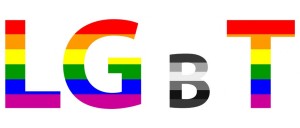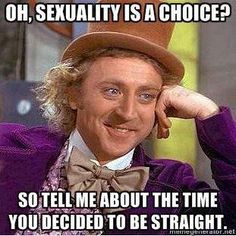The Skeleton in the LGbT’s Closet
Sunday, April 03, 2016 by Jonathan R. Gibbons in
In this post I seek to expose the hypocrisy of biphobic homosexuals and how they are destructive to the LGBT community. I go into great depths to explain the complexities of sexual orientation and the biphobia that is present in the heterosexual community and among academic researchers as well. I dismantle such bull shit as “bisexual men do not exist,” “bisexuality is just a phase,” “sexual orientation is a choice,” and “bisexuals are less capable of monogamy than monosexuals.” Ultimately, I argue that bisexuals should abandon the LGBT community and pursue their own avenues for activism and peer-support. The LGBT community is not a good fit for them. The homosexual community has won their war against legal bigotry, but the battle for bisexuals is an intellectual one… and it is in its’ infancy.
 The Lesbian Gay bisexual & Transgender Community (LGbT) has an ugly skeleton in their closet. Many members of their community fear their bisexual counter-parts. They actually fear or loathe the concept of bisexuality in general. They wish to belittle, denounce and/or reject the very real sexual orientation of one of their core constituencies (bi erasure). Individuals who hold such views are known as biphobe’s and they are just as prevalent within the homosexual community as they are within the heterosexual community (Allen 2015 & Tangela & Hornea & Hoytb 2015). A report conducted by the Equality Network found in a survey of bisexuals that, “The highest amounts of biphobia experienced were within LGBT…” (Rankin & Morton & Bell 2015). Likewise, Beth Sherouse of the Human Rights Campaign summarizes other similar findings, specifically of bisexual youth: ‚Äú’As a bisexual,’ one youth said, ‘I feel shunned by the gay and lesbian community'” (Beth 2015).
The Lesbian Gay bisexual & Transgender Community (LGbT) has an ugly skeleton in their closet. Many members of their community fear their bisexual counter-parts. They actually fear or loathe the concept of bisexuality in general. They wish to belittle, denounce and/or reject the very real sexual orientation of one of their core constituencies (bi erasure). Individuals who hold such views are known as biphobe’s and they are just as prevalent within the homosexual community as they are within the heterosexual community (Allen 2015 & Tangela & Hornea & Hoytb 2015). A report conducted by the Equality Network found in a survey of bisexuals that, “The highest amounts of biphobia experienced were within LGBT…” (Rankin & Morton & Bell 2015). Likewise, Beth Sherouse of the Human Rights Campaign summarizes other similar findings, specifically of bisexual youth: ‚Äú’As a bisexual,’ one youth said, ‘I feel shunned by the gay and lesbian community'” (Beth 2015).
The dominance of biphobe’s is devastating to the well-being of young bisexuals who are trying to make sense of their sexual orientation. When they wish to come out of the closet, they will often turn to their gay friends for advice, often only to be told they are really just gay like them. With the prevalence of suicide being significantly higher among LGbT youth– and mental health problems even higher among bisexuals than homosexuals (Daily Mail Survey) –it should summon enlightened and watchful adults, to provide accurate and careful guidance to youth. Thankfully, contemporary psychology and licensed practitioners are– for the most part –fully versed and skilled in the evaluation of sexual orientation and when a young bisexual seeks out their help, they will likely obtain the guidance they need to cleanse themselves of the bull shit spewed by the biphobe’s on social media and other non-academic internet sources. But people in general turn to their peers or internet sources for help more often than a professional, so it is my goal with this post to rebuke the lies, nonsense, and destructive advice proffered by biphobe’s and to add to the currently small arsenal of objective resources available to bisexuals.
Sexual Orientation
It is important to distinguish between sexual identity and sexual orientation. Sexual identity is how someone chooses to label themselves whether publicly, privately, or internally (Bailey 2009). A woman’s sexual identity may be heterosexual but her actual orientation could be bisexual. Sexual orientation is innate. One has very little control over what they are naturally attracted to; they are born with it programmed into their core instincts. There are primarily three sexual orientation’s a person may truly possess: purely heterosexual (monosexual), bisexual, or purely homosexual (monosexual). There are variances within the spectrum of bisexuality with some individual’s being almost entirely heterosexual but slightly homosexual (hetero-flexible) or on the opposite end (homo-flexible), nonetheless, both of the latter are bisexual because they are in some way shape or form sexually and/or romantically attracted to both sexes/gender’s. So let’s not get drawn into an endless exercise of labels among sub-labels (pansexuals), among yet more sub-labels (polysexuals); these three categories have it covered.
Surprisingly, these fundamentals of psychology and sexual orientation were identified half a century ago but for some reason they remain aloof among many in the LGbT community and among many popular scholars. Alfred Kinsey was an American biologist and sexologist. In the late 1940s and early 1950s, Kinsey and his associates made the following observations:
Males do not represent two discrete populations, heterosexual and homosexual. The world is not to be divided into sheep and goats… The living world is a continuum in each and every one of its aspects.
It is a characteristic of the human mind that tries to dichotomize in its classification of phenomena…Sexual behavior is either normal or abnormal, socially acceptable or unacceptable, heterosexual or homosexual; and many persons do not want to believe that there are gradations in these matters from one to the other extreme. (The Kinsey Institute)
 Dr. Alfred Kinsey
Dr. Alfred KinseyThey ultimately developed what is known as the Kinsey Scale. This provides a visual mapping of an individuals sexuality based on a scale of 0 (heterosexual) to 6 (homosexual); bisexuals fall somewhere in the middle and may slide within this spectrum depending on various factors throughout their lifetimes. In 1978– with some enhancements in 1993 –another American sex researcher, Dr. Fritz Klein (not the Nazi), introduced the Klein Sexual Orientation Grid. Klein wanted to expand upon the research and work of Kinsey and others to provide a more elaborate view of one’s sexuality. Importantly, Klein sought to differentiate the various levels of attraction, e.g. physical attraction, emotional attraction, fantasies, and actual sexual behavior, to establish a more thorough sexual orientation (American Institute of Bisexuality). Both the Kinsey Scale and the Klein Sexual Orientation Grid were important inventions in the discipline of psychology. For those interested in determining their true sexual orientation, the dating application OKCupid provides a thorough test utilizing both Kinsey and Klein’s methods which you may find helpful: The Sexuality Spectrum Test
Sources of Biphobia Among Homosexuals
 We can only speculate on the sources of biphobia within the homosexual community, but perhaps pure homosexuals fear that the existence of bisexuality throws into question their, “I was born gay,” mantra.” “If bisexuality is real, then sexual orientation can be a choice.” The problem is, bisexual is a sexual orientation that people are “born with” as well. Attraction is not a choice, it is subconscious and deeply ingrained in our core psychology; while science has not confirmed the source of homosexual attraction, attraction, in general, has well-established roots in evolutionary psychology and biology (Ridley 2003).
We can only speculate on the sources of biphobia within the homosexual community, but perhaps pure homosexuals fear that the existence of bisexuality throws into question their, “I was born gay,” mantra.” “If bisexuality is real, then sexual orientation can be a choice.” The problem is, bisexual is a sexual orientation that people are “born with” as well. Attraction is not a choice, it is subconscious and deeply ingrained in our core psychology; while science has not confirmed the source of homosexual attraction, attraction, in general, has well-established roots in evolutionary psychology and biology (Ridley 2003).
Bisexuals do not have a choice whether or not they are attracted to both sexes, but they do have a choice in deciding who to have sex with or whether or not to be monogamous with only one sexual partner. Herein lies one source for the distortions spewed by the biphobe’s. Once a bisexual individual is in a monogamous heterosexual, or homosexual, relationship, they are then presumed to be either straight or gay, but it is simply not that simple. Just because a bisexual chooses to be in a monogamous relationship, or to only have sex with one gender, that doesn’t then negate their core sexual attraction, it simply reflects their relationship choices and, perhaps, their more dominant sexual and romantic attraction at a point in time. You may hear a woman say, “I was married to a man but he hurt me so now I only date women… I was always gay and lying to myself,” or a man say, “I used to sleep with women, but I just ended up falling in love with a man… I’m gay now.” None of this changes the core sexual orientation of these individual’s. They are still bisexual. Their level of bisexuality may sway more towards one gender at one point in their life, then another at another point, and the degrees of such attraction may vary, but it does not change their core orientation.
A homosexual can no more enjoy sex with the opposite sex than a heterosexual can with the same sex; the behavior is repulsive to them. It is unlikely they would even be able to perform, i.e. hold an erection or maintain lubrication. If they receive any level of enjoyment from it– even if minuscule –it alludes to their latent bisexual tendencies. Perhaps a bisexual woman enjoys all homosexual activity but oral sex; she is still bisexual. Perhaps a man enjoys all homosexual activity but anal sex; he is still bisexual. Maybe a bisexual only fantasizes about homosexual or heterosexual behavior but doesn’t act on it; they are still bisexual because their biological attraction switches are geared towards more than one sex regardless of their actual sexual behavior and experiences. This really is not rocket science and it is dumbfounding that major scholars and leaders in the LGbT movement do not understand and/or do not articulate these obvious truths.
Lastly, a common myth about bisexuals held by biphobe’s is that they are more prone to infidelity or promiscuity. Why? Just because bisexuals have ‚Äúmore options” for sexual activity does not mean they are any more likely to be unfaithful than monosexuals. They likely find someone they love and are content with, and they simply fantasize from time to time about the potential for heterosexual or homosexual activity. Just as a monosexual man or woman will undoubtedly fantasize about other sexual partners than their monogamous partner. There are terrible people in the world who act on their instincts and do things like deceive and cheat, and then there are honest and faithful individuals. A person‚Äôs core sexual identity does not dictate their moral compass. The prevalence of infidelity within the monosexual community is of great abundance; many are simply wired for monogamy and many are not, regardless of their sexual orientation (Ridley 2003).
Biphobic Heterosexuals and Researchers
A discussion of biphobia would be incomplete without mentioning the unique characteristics of biphobia among heterosexuals. While in the LGbT community biphobia is prevalent against both men and women, within the heterosexual community, biphobia is strongest against bisexual men. “Bisexual men do not exist.” This myth was so strong that in 2005 researchers ran a study to support the myth (Rieger & Chivers & Bailey 2005). J. Michael Bailey explains, “Sexual orientation is commonly described in terms of sexual desire, arousal, fantasy, and attraction. Of these, only one, arousal, can be measured directly and independent of self-report” (Bailey 2009). In other words, the only way to empirically test the existence of bisexual men is to monitor them for erectile activity while watching pornography; when do they “pop a woody.”
Bailey also partook in the 2005 study where they found bisexuals to be nonexistent (Rieger et al. 2005). Wiser researchers debunked the study in 2011 (Rosenthal et al.). Honestly, you would think such research would be unnecessary when one could simply search a porn website for bisexual men and observe empirically that they maintain erections with either sex/gender, but perhaps they felt more inclined to attach nodes to men’s genitalia than to use Google. Academics have to get paid somehow after all. In the Rosenthal et al. (2011) study, they concluded that:
…some men may identify as bisexual because they are sexually aroused by both sexes, even if they experience considerably more arousal to one sex than the other. Alternatively, men with bisexual arousal patterns may experience temporal fluctuations in their attractions and arousal to men and to women. Thus, a bisexual man may be more aroused by male stimuli at one time point but by female stimuli at another time point. Further, his arousal to his less arousing sex may vary in magnitude depending on fluctuations in his attractions to that sex at any given time. (Rosenthal et al. 2011)
No shit Sherlock. Sometimes they feel like a nut and sometimes they don’t. ha. Sometimes a girl wants a hairy chested dude and other times she wants a bare chested guy. Sometimes a man wants a curvy woman and other times a skinny rail. More seriously, sometimes a man loves a woman and sometimes a woman loves a woman; sometimes they both love both. Attraction and love are not just physical, they involve a plethora of other variables. There are a variety of potential attraction switches, e.g. physical attributes (broad shoulders, slender legs, six-pack abs, hour glass curves, youth), emotional attraction (femininity, masculinity, kindness, toughness, dominance), and relational/familial attraction (high status, stability, and ambition). Just ask the ugly pickup artist; they have volumes of material to successfully seduce their more beautiful victims (Strauss 2005).
Lastly, as you review personal accounts of bisexuals, it becomes evident that both men and women express this bi erasure attitude towards male bisexuals. Neil Endicott, a writer for the Huffington Post, recounts one of his experiences telling his girlfriend that he was bisexual; she basically laughed at him and said he’s just confused (Endicott 2015). It can be speculated that there is more biphobia towards men from heterosexuals because, well, bisexual women are hot and women are far more objectified in western culture than men. It is socially acceptable, if not welcomed with a giant grin, for two women– la femme lesbians specifically –to hookup publicly but not for two men. Hence, I suspect some of this gender imbalance found among heterosexual biphobia is simply related to the cultural standard of women being the icons of sexuality and men the drooling-emasculated bystanders.
Taking Action
Bisexuals should dump the lgBt community and the LGT community should move on. The needs of the former are not the same as the latter. Biphobic homosexuals are promoting a culture that encourages bisexual’s to come out of their bisexual closet as homosexual or to remain in their bisexual closet and proclaim heterosexuality. There are young adults throughout the western world who see the nonsense that people within the lgBt community spew and they become anxious, more confused, and in a state of constant distress. Surely some homosexuals choose to lie about being bisexual instead of coming out as gay (Rosenthal et al. 2011), or they are legitimately holding onto the misguided hope that there’s a slight chance they might start liking the opposite sex. All of this is reflective of a behavior specific to homosexuals, not bisexuals. I suspect there are a plethora of closet bisexuals who simply choose to never pronounce their true sexuality as it is simply easier to fit into a “this or that” sexual dichotomy.
Ultimately how one chooses to self identify is entirely up to them. If they are only incidentally bisexual, but mostly heterosexual, then maybe they will choose to identify as straight because it is easier. But I challenge bisexuals to embrace their bisexual orientation no matter how mild it may be and regardless of their current relationship status. If they possess attraction to both sexes, no matter how minuscule, they should embrace it. Instead of saying, “I’m gay,” or, “I’m a lesbian,” or “I’m straight,” simply be accurate and honest. “I’m bisexual but in a committed relationship with a man or a woman.” Period. That’s the truth, and it will help to provide cogency to the various young adults who are struggling with their sexuality when they see how being bisexual does not mean you have to fit into some perfect pigeon hole that monosexual’s wish to foist you in.
“I call myself bisexual because I acknowledge that I have in myself the potential to be attracted‚Äì romantically and/or sexually ‚Äìto people of more than one sex and/or gender, not necessarily at the same time, not necessarily in the same way, and not necessarily to the same degree.” – Robyn Ochs
Sources:
Allen, Samantha. 2015. “Are Bisexual’s Shut Out of the LGBT Club?”. The Daily Beast. http://www.thedailybeast.com/articles/2016/01/03/are-bisexuals-shut-out-of-the-lgbt-club.html.
American Institute of Bisexuality. “The Klein Sexual Orientation Grid”. http://www.americaninstituteofbisexuality.org/thekleingrid/
Bailey, J.M., 2009. What is sexual orientation and do women have one? In: Hope, D.A. (Ed.), The 54th Nebraska SymposiumonMotivation: Contemporary Perspectives on Gay, Lesbian, and Bisexual Identities, vol. 54. , pp. 43–63.
Endicott, Neil. 2015. “Biphobia Is a Destructive Force in Our Community — And It Needs to Stop”. http://www.huffingtonpost.com/neil-endicott/biphobia-is-a-destructive-force-in-our-community_b_7965970.html
Hodgekiss, Anna. 2015. “Bisexual women are ‘more likely to suffer mental health problems than lesbians'”. (Daily Mail Survey)
OKCupid. “The Sexuality Spectrum Test“.
Rankin, Sam., Morton, James., and Matthew Bell. 2015. “Complicated? Bisexual people’s experiences of and ideas for improving services”. Equality Network. Scotland. http://www.equality-network.org/wp-content/uploads/2015/04/Complicated-Bisexual-Report.pdf
Rieger, G., Chivers, M.L., Bailey, J.M., 2005. Sexual arousal patterns of bisexual men. Psychological Science 16, 579–584, doi:10.2307/2137286.
Ridley, Matt. 2003. The Red Queen: Sex and the Evolution of Human Nature
Rosenthal, A.M., et al., Sexual arousal patterns of bisexual men revisited. Biol. Psychol. (2011),
doi:10.1016/j.biopsycho.2011.06.015
Sherouse, Beth. 2015. “New Report from the UK Highlights Biphobia Within and Outside of the LGBT Community”. Human Rights Campaign. http://www.hrc.org/blog/new-report-from-the-uk-highlights-biphobia-within-and-outside-of-the-lgbt-c
Strauss, Neil. 2005. The Game: Penetrating the Secret Society of Pickup Artists. ReganBooks
Tangela S. Robertsa, Sharon G. Hornea & William T. Hoytb. 2015. “Between a Gay and a Straight Place: Bisexual Individuals’ Experiences with Monosexism . Journal of Bisexuality Vol 15.4., 554-569, DOI:10.1080/15299716.2015.1111183
The Kinsey Institute. “Kinsey’s Heterosexual-Homosexual Rating Scale”. http://www.kinseyinstitute.org/research/ak-hhscale.html.



























